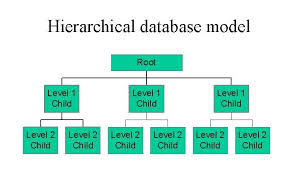Understanding Hierarchical and Network Data Models: Structure, Benefits, and Use Cases
 Shreyash Bante
Shreyash Bante
Hierarchical Data Model
Overview:
The Hierarchical Data Model organizes data in a tree-like structure where records have a parent-child relationship. This model is best suited for situations where data naturally fits into a hierarchy, such as organizational structures or file systems.
In this model, each parent can have multiple children, but each child can only have one parent. This structure resembles a tree, with one root node at the top and various child nodes branching out beneath it.
Key Features:
Tree Structure: Data is arranged in a hierarchy, with each node representing an entity or record.
Parent-Child Relationships: Each parent can have multiple child nodes, but each child can have only one parent, creating a clear and strict hierarchy.
Data Access: To retrieve a specific piece of data, the system must traverse the hierarchy, making it fast for certain types of queries but rigid in structure.
One-to-Many Relationships: The model supports one-to-many relationships between parent and child nodes.
Example:
Consider an organizational chart where each department has employees, and each employee is associated with a single department. This relationship can be modeled hierarchically, with departments being the parent entities and employees as the child entities.
textCopy codeCompany
│
├── HR Department
│ ├── Employee 1
│ └── Employee 2
│
├── IT Department
│ ├── Employee 3
│ └── Employee 4
│
└── Finance Department
├── Employee 5
└── Employee 6
Advantages:
Simplicity: Easy to understand and implement when data follows a natural hierarchy.
Data Integrity: Maintains clear relationships between parent and child entities.
Efficient for Hierarchical Data: Works well for queries that fit the hierarchical structure.
Disadvantages:
Rigidity: It’s difficult to adapt the structure to represent more complex relationships (e.g., many-to-many).
Redundancy: When changes are made, data redundancy can occur since certain child records can only be linked to one parent.
Navigation Complexity: Retrieving records requires traversing the entire hierarchy, which can be inefficient for non-hierarchical queries.
Use Cases:
File Systems: Hierarchical models are used in operating system file structures where directories (folders) contain files or other directories.
Organization Charts: Used to represent employee reporting structures within a company.
XML Data Storage: XML documents are often organized hierarchically, following a tree structure similar to this model.
Network Data Model
Overview:
The Network Data Model is an extension of the hierarchical model, designed to handle more complex relationships between data. In the network model, a record can have multiple parents and multiple children, forming a graph structure instead of a strict tree.
The network model was popular in early database management systems because it provided more flexibility compared to the hierarchical model. It is based on the idea of sets and pointers, where relationships between entities are represented using a set of linked records.
Key Features:
Graph Structure: Unlike the tree-like structure of the hierarchical model, the network model allows records to have more flexible relationships, forming a graph.
Many-to-Many Relationships: This model supports both one-to-many and many-to-many relationships, enabling entities to be connected in more complex ways.
Navigational Access: Data is accessed through pointers, and navigating the network requires following links (pointers) between records.
Set-based Relationships: The model is defined by "sets" that link one record (owner) to another record (member).
Example:
Let’s consider a scenario where employees can work on multiple projects, and projects can have multiple employees. This many-to-many relationship can be represented using a network data model:
textCopy codeProjects
├── Project 1 <-> Employee 1
├── Project 1 <-> Employee 2
├── Project 2 <-> Employee 2
├── Project 2 <-> Employee 3
In this example, Employee 2 is linked to both Project 1 and Project 2, demonstrating a many-to-many relationship.
Advantages:
Flexibility: The network model supports complex relationships such as many-to-many, providing more flexibility than the hierarchical model.
Efficiency: It is efficient for queries that require navigating between related records.
Reduced Redundancy: By allowing multiple relationships, the network model reduces data redundancy compared to hierarchical models.
Disadvantages:
Complexity: The use of pointers and sets makes the network model more complex to implement and maintain.
Navigational Dependency: Queries depend heavily on the explicit paths (pointers) defined between records, which can make certain types of queries difficult to optimize.
Difficult to Scale: As relationships grow in complexity, managing pointers and ensuring data integrity can become increasingly difficult.
Use Cases:
Telecommunication Networks: Used to model connections in communication systems where nodes (e.g., routers) can be connected to multiple other nodes.
Transport Networks: Used for managing complex transportation systems where multiple routes connect various destinations.
Early Database Systems: The network model was used in early database systems like CODASYL to manage complex relationships before relational databases became dominant.
Conclusion:
Both the Hierarchical Data Model and Network Data Model serve important roles in organizing data, especially in early database systems. The hierarchical model works well for data that fits naturally into a tree structure, while the network model provides the flexibility to handle more complex, many-to-many relationships. Understanding these models is crucial for appreciating the evolution of data storage and retrieval systems and how modern database systems have improved upon these early architectures.
Subscribe to my newsletter
Read articles from Shreyash Bante directly inside your inbox. Subscribe to the newsletter, and don't miss out.
Written by

Shreyash Bante
Shreyash Bante
I am a Azure Data Engineer with expertise in PySpark, Scala, Python.